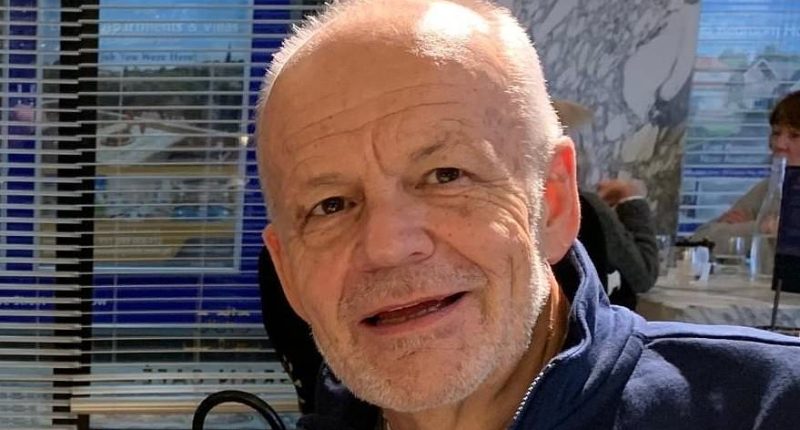Share this @internewscast.com
A terminal cancer patient is taking legal action against his former employer Barclays bank, as he believes exposure to toxic minerals in the building where he worked caused his disease.
Mervyn Jessop, 72, has stage four mesothelioma, an ultra-deadly form of lung cancer associated with exposure to the hazardous material, asbestos.
The father spent 12 years working as a computer operator for the bank giant at a site in Gloucester that housed the firm’s data systems.
But he suspects the ceilings in the purpose-built building were laced with the cancer-causing toxin.
Now, some 30 years after he stopped working in the ‘dusty’ premises, he has been given a year to live.
Studies show that around 80 per cent of mesothelioma cases are a direct result of exposure to asbestos, usually on construction sites.
Mr Jessop’s cancer struggle began at the start of 2024, when he visited his GP about concerns that a cough was not clearing.
He was referred for tests and diagnosed with mesothelioma in October.

Mervyn Jessop, 72, is taking legal action after his work as a computer operator exposed him to asbestos—which he says may be the reason behind his terminal cancer diagnosis
‘I’d heard of mesothelioma on the news, and I knew it was a terminal condition,’ he said.
‘I remember asking the doctor how long I had left and being told I had around 12 months life expectancy.
‘Iwas keen to explore and start treatment as quickly as possible to try and give myself the best chance of having as much time with my family as possible.’
Since his diagnosis Mr Jessop has undergone a medical trial combining chemotherapy and immunotherapy—a form of treatment that works by helping the immune system recognise and attack cancer cells—to try and prolong his life.
Only 10 per cent of those diagnosed with the disease will live for more than five years, research shows.
‘At present I get breathless if I try and do too much,’ said Mr Jessop.
‘I can manage walking on flat ground; however, I can’t do any heavy tasks around the house and garden like I used to.
‘Unfortunately, I have just resigned from my golf club as I can no longer play due to getting breathless on walking any inclines.

The father has stage four mesothelioma, a terminal form of lung cancer associated with exposure to the hazardous material, often decades previously. He believes it stems from his exposure to asbestos while working at Barclays Bank data centre from the early 90s (pictured)

He has now instructed specialist asbestos-related disease lawyers to investigate whether his illness could be linked to his career and is appealing to his ex-workmates to come forward with information
‘When I look into the future, I feel very sad. We had a lot of plans for our retirement, and I feel that they have all been taken away.
‘I worry about what will happen to me, and about what will happen to my wife Karen and our family.’
Mr Jessop joined Barclays in 1973. Initially based in London, he moved to Barnwood in 1978 when the Gloucester Data Centre opened.
The facility, which had three blocks—A, B and C—housed the firm’s expanding computer network.
He was based in A block, which is said to have had raised floors and suspended ceilings.
A significant amounts of computer cabling and general wiring ran through the floors and ceilings, according to Mr Jessop.
This would disturb ceiling tiles and debris behind the ceilings, which he suspects contained asbestos. As a result, dust would circulate.
Engineers would also dislodge tiles when carrying out repairs.
‘Most of my working hours were outside office hours and this is when most of the maintenance work on the computers was carried out,’ said Mr Jessop.
‘At that time, computers were in their infancy. They were enormous, often filling an entire room, with numerous buttons, switches and cables, so when engineering work was required, it was a big job, involving several people.
‘The work usually meant accessing areas behind the suspended ceilings and underneath the floors, and these areas were often dusty. So great care was required when cleaning up to keep the areas clean and dust free.’
Mr Jessop relocated to the North West in 1990, living in Wilmslow, Cheshire. He retired from Barclays in 2004.
It is believed that the Gloucester Data Centre underwent a re-fit in 2001 when asbestos may have been removed from the building.
Asbestos is a naturally-occurring mineral used extensively between the 1950s and 1990s as a cheap insulator in the construction of most new buildings.
Inhaling its microscopic fibres can cause lung cancers (including mesothelioma), as well as asbestosis, an excruciating inflammation and scarring of the lungs.
Mesothelioma is responsible for around 2,400 deaths each year, according to Cancer Research UK.

The Mail’s Asbestos: Britain’s Hidden Killer campaign demands that a phased removal of asbestos must begin with schools and hospitals
The Health and Safety Executive estimates that 1.3 million tradespeople are at risk of exposure, and they could come into contact with asbestos on average more than 100 times a year
Approximately 5,000 Britons die every year from asbestos-related cancers caused by work-related exposure, according to the Institution of Occupational Safety and Health.
Most cases are diagnosed among people aged 75 or over, with men more often affected than women.
Symptoms of the disease build up over time and usually appear a number of decades after someone is exposed to asbestos.
Mr Jessop added: ‘I know I can’t undo what’s happened but the least I feel I deserve is answers regarding how I was exposed to asbestos.
‘It would mean so much to me and my family if people could come forward with information.’
He has now instructed specialist asbestos-related disease lawyers to investigate whether his illness could be linked to his career and is appealing to his ex-workmates to come forward with information.
The legal team is keen to hear from anyone who worked with Mervyn at Barclays Bank’s Gloucester Data Centre in Barnwood near Gloucester.
Helen Tomlin, the specialist asbestos-related disease lawyer representing Mervyn, said: ‘Mervyn’s diagnosis is yet another reminder of the devastating impact of asbestos and how the repercussions of exposure are often only known years later.
‘Mervyn and his family remain devastated by his diagnosis and what it may mean for the future. While many people often associate asbestos with heavy industry, its use was a lot more widespread.
‘If anyone who remembers working with Mervyn, or who has information about the Gloucester Data Centre could come forward, it could prove vital in at least providing Mervyn and his family with the answers they deserve.’
Anyone with information should contact Mr Jessops legal team at Irwin Mitchell.














